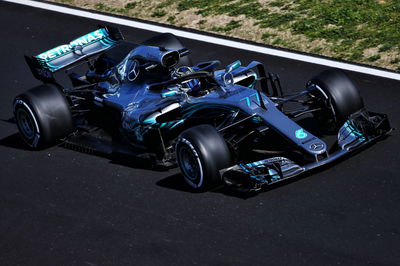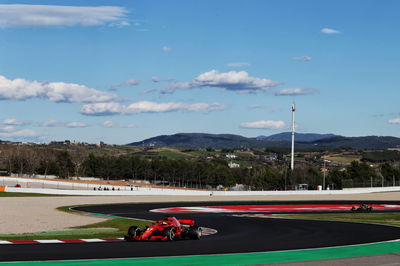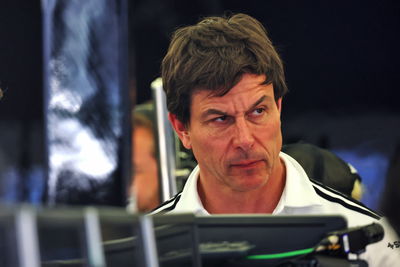F1 Testing Analysis: Mercedes’ long-run pace offers ominous signs
Sebastian Vettel may have obliterated the existing track record on the morning of day three of the final Formula 1 pre-season test in Barcelona, but a look at the numbers suggests Ferrari may not hold the advantage reflected in the end-of-day timesheets.

Sebastian Vettel may have obliterated the existing track record on the morning of day three of the final Formula 1 pre-season test in Barcelona, but a look at the numbers suggests Ferrari may not hold the advantage reflected in the end-of-day timesheets.
Wednesday saw Daniel Ricciardo finally topple the track record at the Circuit de Barcelona-Catalunya that had dated back to 2008, but Vettel was able to deliver a string of huge laps on the hypersoft compound, eventually lapping almost nine-tenths of a second quicker than Red Bull driver.
There were excited gasps around the media centre as Vettel continually improved his lap time, finding a few additional tenths after each cool lap on his hypersoft tyres. The four-time F1 world champion’s best lap came in at 1:17.182 - and given he appeared to be easing off crossing the line, there may be even more time on offer.
The question during the lunch break was whether Mercedes would act in kind and go for its own hypersoft run. Valtteri Bottas had spent the morning session purely on the medium compound tyre, conducting three stints to a race distance en route to a lowly P9 in the standings.
Bottas handed over to teammate Lewis Hamilton for the afternoon running, and the Briton followed a similar programme. Mercedes soon confirmed to reporters that it had in fact not even brought the hypersoft tyre to Barcelona, with its limited usage this season offering little real value in completing much running through testing in the eyes of the team.
Vettel’s headline time may have dominated the session reports and much of the talk about today’s test running, but the German wanted to take it with a pinch of salt.
“It’s just a time,” Vettel said.” There’s been a lot of times, what’s important is the car was working all day. Overall the conditions were better than yesterday. It’s always difficult to compare but it matters in a couple of week’s time, that’s when its serious.”
Vettel ended with the day with a mammoth 188 laps to his name to conclude his winter testing programme, completing a race simulation in the afternoon before handing over to Kimi Raikkonen for Friday. Red Bull opted to also complete a race simulation with Max Verstappen in the car, giving us a chance to crunch the numbers for how the ‘big three’ may stack up in terms of long-run pace.
Bottas and Verstappen’s race simulations were not entirely representative of what we will see at the race in May as they completed all three stints on the medium tyre. Vettel’s was more resemblant of a real race run as he went supersoft/medium/medium for his simulation.
“We got a smooth run, no car issues, no red flags, so we could get through,” Vettel said of his race simulation. “Also for the guys, they did the stops, so that was solid. I don’t know in terms of pace, you always think you could have done better here and there, just like racing - but it was OK.”
But if you were hoping to see a change at the very top, it might be best to look away now…
Stitching together the three stints, it becomes clear that Bottas’ race simulation was significantly faster than those of both Vettel and Verstappen. While it is impossible to make any firm assessments given varying fuel loads, possible lifts to hide advantage and other duties on the programme, all three completed three straight stints as part of a race simulation. Bottas and Vettel’s three runs combined came to 66 laps exactly - the race distance for the Spanish Grand Prix - while Verstappen’s added up to 63.
Despite being on mediums for his first stint compared to Vettel’s supersofts, Bottas still enjoyed a decent pace advantage. His first salvo of 29 laps - nearly half a race distance - was highly consistent, with the late-stint pace being comparable to that of Vettel’s when he was out on fresh mediums. Verstappen, meanwhile, was further adrift and a little more inconsistent.
The further into the stint you go, the bigger Bottas’ advantage becomes. Come his final 20-lap stint, he was regularly dipping into the high 1:19s territory; Vettel was typically in the low 1:21s.
Mercedes could be looking at a long-run pace advantage of as much as one second per lap, with Ferrari and Red Bull seeming to be close together in a duel to be second-fastest. We did get see a brief glimpse of what Vettel may really be able to do as he turned in a 1:19 time on the final flying lap of his stint - but even that didn’t near Bottas’ regular times.
For all of the buzz surrounding Vettel’s hypersoft time in the morning, Mercedes will be coming out of today looking in really good shape. A pinch of salt may be needed before making any firm deductions about the pecking order - but if the numbers hold up, Mercedes has good reason to be quietly confident.











